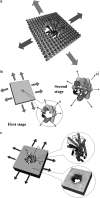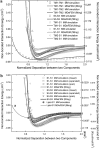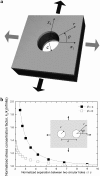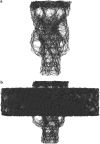Gating mechanisms of mechanosensitive channels of large conductance, I: a continuum mechanics-based hierarchical framework
- PMID: 18390626
- PMCID: PMC2440431
- DOI: 10.1529/biophysj.107.128488
Gating mechanisms of mechanosensitive channels of large conductance, I: a continuum mechanics-based hierarchical framework
Abstract
A hierarchical simulation framework that integrates information from molecular dynamics (MD) simulations into a continuum model is established to study the mechanical response of mechanosensitive channel of large-conductance (MscL) using the finite element method (FEM). The proposed MD-decorated FEM (MDeFEM) approach is used to explore the detailed gating mechanisms of the MscL in Escherichia coli embedded in a palmitoyloleoylphosphatidylethanolamine lipid bilayer. In Part I of this study, the framework of MDeFEM is established. The transmembrane and cytoplasmic helices are taken to be elastic rods, the loops are modeled as springs, and the lipid bilayer is approximated by a three-layer sheet. The mechanical properties of the continuum components, as well as their interactions, are derived from molecular simulations based on atomic force fields. In addition, analytical closed-form continuum model and elastic network model are established to complement the MDeFEM approach and to capture the most essential features of gating. In Part II of this study, the detailed gating mechanisms of E. coli-MscL under various types of loading are presented and compared with experiments, structural model, and all-atom simulations, as well as the analytical models established in Part I. It is envisioned that such a hierarchical multiscale framework will find great value in the study of a variety of biological processes involving complex mechanical deformations such as muscle contraction and mechanotransduction.
Figures










Similar articles
-
Gating mechanisms of mechanosensitive channels of large conductance, II: systematic study of conformational transitions.Biophys J. 2008 Jul;95(2):581-96. doi: 10.1529/biophysj.107.128496. Epub 2008 Apr 4. Biophys J. 2008. PMID: 18390625 Free PMC article.
-
A finite element framework for studying the mechanical response of macromolecules: application to the gating of the mechanosensitive channel MscL.Biophys J. 2006 Aug 15;91(4):1248-63. doi: 10.1529/biophysj.106.085985. Epub 2006 May 26. Biophys J. 2006. PMID: 16731564 Free PMC article.
-
Mechanosensitive channels: insights from continuum-based simulations.Cell Biochem Biophys. 2008;52(1):1-18. doi: 10.1007/s12013-008-9024-5. Epub 2008 Sep 12. Cell Biochem Biophys. 2008. PMID: 18787764 Free PMC article. Review.
-
Gating of MscL studied by steered molecular dynamics.Biophys J. 2003 Oct;85(4):2087-99. doi: 10.1016/S0006-3495(03)74637-2. Biophys J. 2003. PMID: 14507677 Free PMC article.
-
MscL: channeling membrane tension.Pflugers Arch. 2015 Jan;467(1):15-25. doi: 10.1007/s00424-014-1535-x. Epub 2014 May 27. Pflugers Arch. 2015. PMID: 24859800 Free PMC article. Review.
Cited by
-
Emerging roles for lipids in shaping membrane-protein function.Nature. 2009 May 21;459(7245):379-85. doi: 10.1038/nature08147. Nature. 2009. PMID: 19458714 Free PMC article. Review.
-
Nanomechanical properties of MscL α helices: A steered molecular dynamics study.Channels (Austin). 2017 May 4;11(3):209-223. doi: 10.1080/19336950.2016.1249077. Epub 2016 Oct 18. Channels (Austin). 2017. PMID: 27753526 Free PMC article.
-
The role of MscL amphipathic N terminus indicates a blueprint for bilayer-mediated gating of mechanosensitive channels.Nat Commun. 2016 Jun 22;7:11984. doi: 10.1038/ncomms11984. Nat Commun. 2016. PMID: 27329693 Free PMC article.
-
Mechanical Activation of MscL Revealed by a Locally Distributed Tension Molecular Dynamics Approach.Biophys J. 2021 Jan 19;120(2):232-242. doi: 10.1016/j.bpj.2020.11.2274. Epub 2020 Dec 15. Biophys J. 2021. PMID: 33333032 Free PMC article.
-
Pulling MscL open via N-terminal and TM1 helices: A computational study towards engineering an MscL nanovalve.PLoS One. 2017 Aug 31;12(8):e0183822. doi: 10.1371/journal.pone.0183822. eCollection 2017. PLoS One. 2017. PMID: 28859093 Free PMC article.
References
-
- Alberts, B., D. Bray, J. Lewis, M. Raff, K. Roberts, and J. D. Watson. 1994. Molecular Biology of the Cell. Garland Publishing, New York and London.
-
- Kung, C. 2005. A possible unifying principle for mechanosensation. Nature. 436:647–654. - PubMed
-
- Hamill, O. P., and B. Martinac. 2001. Molecular basis of mechanotransduction in living cells. Physiol. Rev. 81:685–740. - PubMed
-
- Martinac, B. 2004. Mechanosensitive ion channels: molecules of mechanotransduction. J. Cell Sci. 117:2449–2460. - PubMed
-
- Perozo, E., A. Kloda, D. M. Cortes, and B. Martinac. 2002. Physical principles underlying the transduction of bilayer deformation forces during mechanosensitive channel gating. Nat. Struct. Biol. 9:696–703. - PubMed
Publication types
MeSH terms
Substances
Grants and funding
LinkOut - more resources
Full Text Sources
Other Literature Sources
Molecular Biology Databases

